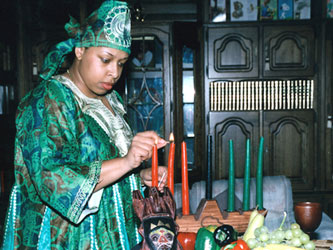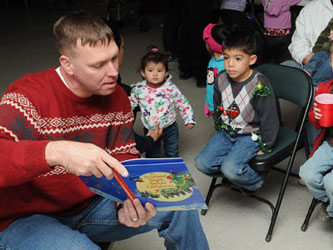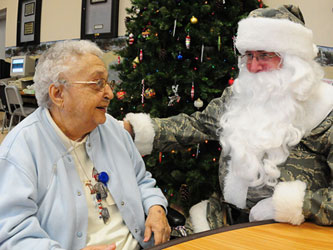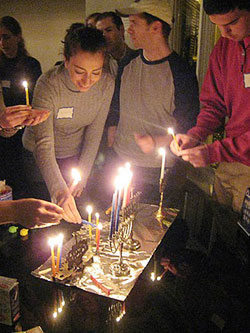Not a Jolly Holiday? Use this Guide to Find Gratitude in the Season
December 11, 2015
Navigating through a jolly holiday season and wishing for a wonderful new year when caring for someone with a chronic, debilitating health condition might have you thinking, “This is no holiday!” But we keep hearing that expressing thanks can lead to a healthier, happier, and less-stressed life. Noted expert Robert Emmons defines gratitude in part as, “… an affirmation of goodness. We affirm that there are good things in the world, gifts and benefits we’ve received. This doesn’t mean that life is perfect; it doesn’t ignore complaints, burdens, and hassles. But when we look at life as a whole, gratitude encourages us to identify some amount of goodness in our life.”
 Family caregivers are often portrayed as the epitome of goodness, and rightly so. Time and again spouses, adult children, other relatives, and friends who care for loved ones with Alzheimer’s, stroke, PTSD, TBI, and other health conditions, dig deep to put the needs of another before their own needs. They move personal life priorities to the back burner— work, family, travel, their own health — to ensure the safety and well-being of another person.
Family caregivers are often portrayed as the epitome of goodness, and rightly so. Time and again spouses, adult children, other relatives, and friends who care for loved ones with Alzheimer’s, stroke, PTSD, TBI, and other health conditions, dig deep to put the needs of another before their own needs. They move personal life priorities to the back burner— work, family, travel, their own health — to ensure the safety and well-being of another person.
But no well is bottomless and no caregiver can give in a limitless manner. Oane can’t always be kind, on-alert, supportive, compassionate, protective, and more, without doing harm to you. In this season of giving, acknowledgment of the giving that goes on all year long can get overlooked.
As a caregiver, there are ways to cultivate a greater sense of satisfaction coupled with a culture of gratitude for the holidays, both for the person receiving care and for you.
To get a start, try these steps to help focus your actions:
Connect with people.
 Holiday time is both about spending time with people we truly enjoy, but also with those to whom we feel obligated. Here’s a very specific exercise to help identify who receives your precious time during this season. Write down the names of family and friends with whom you’re likely to spend significant time this holiday season. Put a (*) by the names with whom you have a relatively simple, uncomplicated, mutually beneficial relationship. Mark an (x) by those people who make you feel uncomfortable (tense, inferior, frustrated, guilty, etc.). Ideally, would you like to spend (1) more, (2) less, or (3) about the same amount of time with each person on your list? Put a 1, 2 or 3 after each name.
Holiday time is both about spending time with people we truly enjoy, but also with those to whom we feel obligated. Here’s a very specific exercise to help identify who receives your precious time during this season. Write down the names of family and friends with whom you’re likely to spend significant time this holiday season. Put a (*) by the names with whom you have a relatively simple, uncomplicated, mutually beneficial relationship. Mark an (x) by those people who make you feel uncomfortable (tense, inferior, frustrated, guilty, etc.). Ideally, would you like to spend (1) more, (2) less, or (3) about the same amount of time with each person on your list? Put a 1, 2 or 3 after each name.
Embrace the season’s activities.
 We often enter into the holidays wanting to be inclusive and accommodating. Every year family and friends gather to share meals and exchange gifts. Why should this year be any different? Write down all of the activities you look forward to or anticipate doing as part of the holidays. Here are a few to help you get started: Buy gifts, decorate, make travel plans, plan and shop for holiday meals, cook, bake, clean, host guests, host grandchildren, volunteer for charitable causes, participate in spiritual or religious activities, participate in special family traditions (travel to a family gathering out-of-state, make tamales, sing at the local VA nursing home), and more. The list may sound both endless and compelling. Now revisit your list. Put a (*) by the activities that make you smile and feel content. Mark an (x) by the activities that you do not have time to fully enjoy, or that seem to have lost their meaning or become a burden for you, the person you care for, or your family.
We often enter into the holidays wanting to be inclusive and accommodating. Every year family and friends gather to share meals and exchange gifts. Why should this year be any different? Write down all of the activities you look forward to or anticipate doing as part of the holidays. Here are a few to help you get started: Buy gifts, decorate, make travel plans, plan and shop for holiday meals, cook, bake, clean, host guests, host grandchildren, volunteer for charitable causes, participate in spiritual or religious activities, participate in special family traditions (travel to a family gathering out-of-state, make tamales, sing at the local VA nursing home), and more. The list may sound both endless and compelling. Now revisit your list. Put a (*) by the activities that make you smile and feel content. Mark an (x) by the activities that you do not have time to fully enjoy, or that seem to have lost their meaning or become a burden for you, the person you care for, or your family.
Cultivate a sense of goodwill towards yourself and others.
At this time of year there is more pressure to appear happy and joyful. Feeling and expressing your true feelings, especially if these truths appear negative to others, can be discouraged and seen, at the least, as not acting in the spirit of the season. Here are some of the feelings that family caregivers have expressed to us, as well as some from those on the care receiving end of the relationship. See if any of these fit for you: ambivalence, anxiety, anger, boredom, embarrassment, exhaustion, frustration, forgotten, happiness, hopeful, grateful, grief, guilt, impatience, irritability, jealousy, loving, loneliness, loss, peaceful, resentment, sadness, satisfaction, scared, thankful, tired, worried, zapped, and zestful. List any other feeling you know to be true for you. Now put a (1) by the feelings that get in the way or disrupt your life, a (2) by the feelings that just are there but don’t really get in the way, and a (3) by the feelings that you want to cultivate to feel more often.
What is doable and what reflects wishful thinking?
 To complete this exercise, draw a line down the middle of a piece of paper. On the left side of the page note your 1s from the first exercise, now write down the (*)s from the second exercise, and add the 3s from the third exercise. List the remaining items on the right side of the page. When you have finished scan your lists. What steps can you take to include more of the people, activities, and feelings from the left side of the page into this holiday season or the near future? What items reflect wishful thinking but more realistically represent something to hope for some time in the future?
To complete this exercise, draw a line down the middle of a piece of paper. On the left side of the page note your 1s from the first exercise, now write down the (*)s from the second exercise, and add the 3s from the third exercise. List the remaining items on the right side of the page. When you have finished scan your lists. What steps can you take to include more of the people, activities, and feelings from the left side of the page into this holiday season or the near future? What items reflect wishful thinking but more realistically represent something to hope for some time in the future?
Here are few examples of actions to take this season:
Give the gift of listening.
Putting everything else aside to focus your full attention on a loved one. Just be present, listening to them tell you a story or share their thoughts; ask questions about the origin of family stories and rituals, share a chuckle over past adventures.
Communicate gently but honestly.
 Tell the person you care for or the person who cares for you, sensitively but honestly, what you need and how you would like to meet that need. It’s better than speaking angrily or resentfully with the person you care for. Sometimes you might just need some time away from the care situation. Try these suggestions for communication with someone living with brain impairment.
Tell the person you care for or the person who cares for you, sensitively but honestly, what you need and how you would like to meet that need. It’s better than speaking angrily or resentfully with the person you care for. Sometimes you might just need some time away from the care situation. Try these suggestions for communication with someone living with brain impairment.
Revisit expectations.
If you are caring for a family member living with moderate to severe PTSD or Alzheimer’s disease, making heroic efforts to include your relative in a holiday gatherings can be tense and exhausting. Sometimes it can work wonderfully when family members and friends pitch in so that you can take a break to enjoy yourself. But, too often caregiving tasks and anxiety about actions by the person can drain any enjoyment from your time at the event. Encourage family and friends to spend time with your family member with dementia by visiting the person where they live, rather than at loud, busy family gatherings. A smaller gathering in more familiar surroundings gives visitors and hosts a much greater chance for meaningful time together. Here are more tips for navigating dementia care during the holidays.
Cultivate gratitude in your life.
 What would it feel like to focus more of your thoughts on what is good in life? If you have time, consider keeping a gratitude journal, writing down a few items each day. Reading just a few sentences from your journal before you go to bed and when you wake up can help you to focus on the good in your life. As a way to communicate within the family, some people create a “gratitude bowl” where everyone in the household jots down things they are grateful for on a slip of paper and places them in the container. Read a few of the slips out loud each day when you’re together at meal time or post a gratitude note on the refrigerator.
What would it feel like to focus more of your thoughts on what is good in life? If you have time, consider keeping a gratitude journal, writing down a few items each day. Reading just a few sentences from your journal before you go to bed and when you wake up can help you to focus on the good in your life. As a way to communicate within the family, some people create a “gratitude bowl” where everyone in the household jots down things they are grateful for on a slip of paper and places them in the container. Read a few of the slips out loud each day when you’re together at meal time or post a gratitude note on the refrigerator.
Navigating the holidays on top of all of the other daily activities of life for those living with chronic illness can be fraught with frustration and a sense of disappointment. Giving thought to what is truly important for you and your family, while taking steps to communicate your interests to others can open up opportunities for you to have a less stressful and more satisfying season.
May Peace be Your Gift for the Winter Holidays
and Your Blessing all Year Through!
— Leah Eskenazi, Family Caregiver Alliance
Additional Resources:
FCA
Caregiving for the Holidays: From Stress to Success
https://www.caregiver.org/caregiving-and-holidays-stress-success
Alzheimer’s Disease and Caregiving
https://www.caregiver.org/alzheimers-disease-caregiving
Caregivers Guide to Understanding Dementia Behaviors
https://www.caregiver.org/caregivers-guide-understanding-dementia-behaviors
VA
I am a Caregiver/Family Member
www.va.gov/opa/persona/caregiver_family.asp
Information & Support for In-Home Dementia Caregivers
www.ruralhealth.va.gov/vets/resources.asp#support
Photos from top to bottom:
By Irais Esparza (Own work Naucalpan de Juárez, Edo. México) [CC BY-SA 4.0 (https://creativecommons.org/licenses/by-sa/4.0/)], via Wikimedia Commons
By A1C Preston Webb [Public domain], via Wikimedia Commons
File: Kwanzaa-Myers.jpg [Public domain], via Wikimedia Commons
By Sgt. Quentin Johnson (https://www.dvidshub.net/image/804212/mustangs-host-christmas-party-build-family-morale) [Public domain], via Wikimedia Commons
By Senior Master Sgt. David Lipp (https://www.dvidshub.net/image/350068/guardsmen-bring-christmas-veterans) [Public domain], via Wikimedia Commons
By Photo taken for DC Minyan by Rebecca Israel. [CC BY-SA 3.0 (https://creativecommons.org/licenses/by-sa/4.0/)], via Wikimedia Commons
